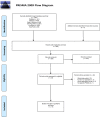Patient-reported outcome measures in vitreoretinal surgery: a systematic review
- PMID: 35550605
- PMCID: PMC9905525
- DOI: 10.1038/s41433-022-02073-8
Patient-reported outcome measures in vitreoretinal surgery: a systematic review
Abstract
This review article systematically reviews the use of Patient Reported Outcome Measures (PROMs) in Vitreoretinal surgery, with the aim of recommending a preferred PROM-tool for use in clinical practice. Vitreoretinal surgery lags behind other ophthalmic subspecialties in the adoption of PROMs as a core outcome measure of success post-operatively. Current outcomes rely heavily on post-operative Best Corrected Visual Acuity (BCVA) and anatomical success on imaging modalities such as Ocular Coherence Tomography (OCT), despite the link between each of these measures and patient satisfaction being uncertain. We systematically reviewed the available literature in March 2021, in accordance with PRISMA guidelines, searching six databases: MEDLINE, EMBASE, Web of Science, APA PsycINFO, SCOPUS and Cochrane Library. Critical appraisal of PROM-tools was facilitated using the COnsensus-based Standards for the selection of health Measurement INstruments (COSMIN) risk of bias checklist. We identified 14 eligible original research papers that used PROMs as a primary or secondary outcome of success post-operatively in patients having undergone vitreoretinal surgery. Eight different generic and vision-related PROM-tools were identified as being used in vitreoretinal studies, none of which were vitreoretinal-disease-specific. Our review article considers whether generic-health PROMs (e.g., EQ5D) or vision-related PROMs (e.g. NEI VFQ-25) are precise or responsive enough following vitreoretinal surgery to have a meaningful impact on clinical or research practice. We also consider the importance of standardisation of clinical outcomes in vitreoretinal clinical trials.
摘要: 本文系统回顾了由患者报告的结局量表 (PROMs) 在玻璃体视网膜手术中的应用, 旨在为临床实践推荐首选的PROM量表。在采用PROMs作为评价手术成功的核心结局指标这方面, 玻璃体视网膜手术落后于其他眼科亚专业的手术。目前, 玻璃体视网膜手术的预后评价主要依赖于术后最佳矫正视力 (BCVA) 和成像方面的解剖成功率 (相干光断层扫描技术), 尽管这些指标与患者满意度之间的关联尚不清楚。我们根据PRISMA指南, 对2021年3月现有的文献进行了系统综述, 共检索了6个数据库: MEDLINE、EMBASE、Web of Science、APA PsycINFO、SCOPUS和Cochrane Library。我们基于COnsensus标准, 选择健康测量量表 (COSMIN) 偏倚风险检查表对PROM量表进行了严格评估。我们筛选了14篇符合条件的原始研究, 这些研究将PROMs作为玻璃体视网膜手术成功的主要或次要结局评价指标。8种不同的通用的以及和视觉相关的PROM量表被确定用于玻璃体视网膜研究, 但都不具有玻璃体视网膜疾病的特异性。本文探究了玻璃体视网膜术后, 全身健康相关的PROMs (如EQ5D) 或视觉相关的PROMs (如NEI VFQ-25) 是否能做到精确评估或足够灵敏, 从而对临床试验或研究转化产生有意义的影响。我们还讨论了玻璃体视网膜临床试验中临床结果标准化的重要性。.
© 2022. Crown.
Conflict of interest statement
The authors declare no competing interests.
Figures
References
-
- Devlin NJ, Parkin D, Browne J. Patient-reported outcome measures in the NHS: new methods for analysing and reporting EQ-5D data. Health Economics. 2010;19:886–905. - PubMed
-
- Novick MR. The axioms and principal results of classical test theory. Journal of Mathematical Psychology. 1966;3:1–18.
-
- Chang C-H, Reeve BB. Item response theory and its applications to patient-reported outcomes measurement. Evaluation & the Health Professions. 2005;28:264–82. - PubMed
Publication types
MeSH terms
LinkOut - more resources
Full Text Sources


